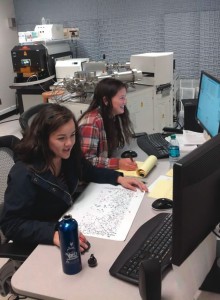
Sally Shatford ’15 and Carolyn Nuyen ’15 at work in the laser-ablation mass spectrometry laboratory at the University of Arizona during March 2014 spring break. They analyzed grains of the mineral zircon that constituted a small part of the Tava sandstone, then determined the uranium-lead age for each grain, as a step on the way to determining the formation age for the Tava formation.
Geology Professor Christine Smith Siddoway and CC geology students have made an astounding discovery in the rocks of Colorado, near Colorado Springs. Their findings, published by the Geological Society of America and published widely in the geology world, detail a sandstone formation amid surrounding granite. Siddoway notes that the sandstone is of major significance for Colorado and the eastern Rocky Mountains because it formed during the Cryogenian Period of geological time, for which there had been no known sedimentary record for this sizable region.
This formation, called Tava sandstone, occurs as sedimentary intrusions within the surrounding ancient granite and gneisses that form the spine of the Colorado Front Range. Features of the rock show that catastrophic processes of liquefaction and sediment remobilization — of the sort that may be achieved by earthquake shaking — are responsible for driving the sediment into the host rocks. The name Tava derives from the Ute word for sun, and is a reference to the Ute name for Pikes Peak: “Tavakiev” – Sun Mountain.
The nearby exposures of Tava sandstone stretch across the face of Cheyenne Mountain from NORAD to North Cheyenne Canyon, and can be seen in areas in Manitou Springs, Crystola, and Woodland Park.